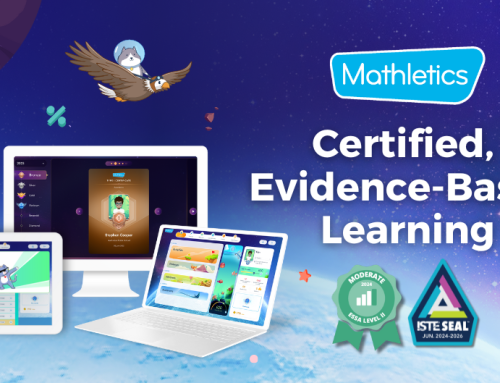How does a top-performing school push the boundaries of maths education? Wallace Fields Junior School has the formula.
Located in Epsom, UK, this two-form entry junior school continues to innovate despite its already impressive track record. With maths results consistently above the national average, Wallace Fields is focusing on further enhancing their curriculum.
The school’s objective is clear: develop maths mastery across all year groups, from Year 3 to Year 6, while improving engagement and accessibility for every student.
Katie Sarjeant, Year 5 Class Teacher and Maths Lead, shares how our online maths program, Mathletics, has become an integral part of their continued success.
The story of Wallace Fields Junior School
Wallace Fields Junior School caters to students from Year 3 to Year 6. As a high-achieving school, they constantly strive to maintain and improve their academic standards.
Katie Sarjeant, who has been in her role for three years, is part of the senior leadership team and oversees the maths curriculum across the school.
Their recent focus has been on developing maths mastery consistently across all year groups and raising the profile of maths for lower attaining students.
The challenge of consistent maths mastery
While Wallace Fields had already implemented a maths mastery approach, they wanted to ensure consistency across all year groups.
They needed a solution that would:
- Reinforce maths mastery principles throughout the school
- Provide diverse contexts for students to deepen their understanding
- Support efficient teacher workload management
- Boost student engagement both in and out of the classroom
- Seamlessly align homework and independent practice with classroom learning.
Why Mathletics?
Katie explains their decision to integrate Mathletics into their curriculum:
“The reason we chose Mathletics and why we’re still using it after all these years is because it gives the opportunity for children to develop their learning in and outside of school and it gives them the chance to really do exactly what the mastery approach is – which is deepen their understanding in different contexts.”
Key factors that made Mathletics an ideal fit for Wallace Fields included:
- Seamless alignment with White Rose Maths, their chosen curriculum
- Strong support for their mastery approach
- User-friendly interface benefiting both teachers and students
- Efficient workload management through automated marking and progress tracking
- An engaging platform that motivates students to practise maths skills.
By choosing Mathletics, Wallace Fields Junior School found a program that not only complemented their existing strengths but also opened new avenues for growth and excellence.

Mathletics in action at Wallace Fields
Mathletics has provided Wallace Fields with a comprehensive solution that addresses their needs:
- Consistent maths mastery: The program’s close alignment with White Rose Maths, the school’s chosen curriculum, ensures consistency across year groups. Katie shares:
“We’ve had positive feedback from governors about Mathletics and how it complements the curriculum we’re delivering… that’s another reason why we’ve decided to stay with Mathletics every year – because it matches up exactly with what we’re teaching.”
- Diverse learning contexts: Mathletics extends learning beyond the classroom, providing opportunities for students to deepen their understanding through diverse contexts. Katie explains:
“We use Mathletics for homework every single week and most year groups use it during the week for consolidation of units covered, giving the children an independent chance to show what they know and then being able to plug those gaps.”
- Efficient workload management: Mathletics streamlines administrative tasks while maintaining effective assessment practices. This approach also eliminates manual marking and provides visual feedback, allowing teachers to quickly identify areas needing attention. Katie notes:
“It’s really good for teacher workload because the ownership is on the child and the responsibility to follow up is very clear in Mathletics.”

The results
Wallace Fields Junior School has experienced wide-ranging benefits since implementing Mathletics:
- Improved student engagement: Observing consistent participation and effort, Katie explains how Mathletics supports student autonomy:
“It’s nice because they’re taking ownership over their own learning.” She describes how she encourages students to use Mathletics to work on topics they found difficult, especially when consolidating the year’s curriculum. Highlighting the widespread adoption of Mathletics, Katie concludes: “They do seem really engaged, the whole school does, to be honest!”
- Enhanced mastery and differentiation: Mathletics’ versatility allows Wallace Fields to cater to diverse learning needs, as Katie highlights:
“The Skills Quests are really good because they add a slightly more challenging element… I especially like that both elements are there… because for some children fluency is what they need to focus on and we as a school go between needing to focus more on fluency, then needing to focus more on reasoning.”
- Data-driven instruction: Mathletics provides valuable insights that enable teachers to tailor their instruction effectively. Katie elaborates:
“It gives (students) time to show what they can independently do and then you can plug those gaps as the year goes on. You can see trends if perhaps they found a whole unit tricky… then it’s very clear that’s the area to work on that perhaps you wouldn’t see in the classroom.”
- Improved planning and transition: Mathletics’ data has enhanced year-to-year planning at Wallace Fields, allowing teachers to identify focus areas for incoming classes with precision. Katie elaborates:
“I’ve been printing out the results at the end of the year to give to the next teacher so when they start the new year they can work on priorities.” Katie further explains, “It really helps in terms of the small steps. For example, you might know your children found the majority of fractions okay, but converting between improper fractions and mixed numbers, they found that specific area tricky. Without Mathletics, you wouldn’t know this off the top of your head.”
- Increased parental engagement: Mathletics has facilitated more conversations between parents and children about maths with Katie noting:
“I like that parents know exactly what we’re focusing on each week so they know what their children are learning and they can support their children and have good conversations with their children like, ‘How would you do this?’ and ‘How did you do this in school?’.”
- Supporting high academic achievement: As a high-performing school with maths results above the national average, Wallace Fields Junior School has found Mathletics to be an excellent tool for challenging and supporting their students. Katie explains:
“The maths results are amazing and the Skills Quests in Mathletics give our students an opportunity to be more challenged than the fluency-style exercises.”

Mathletics at Wallace Fields: ‘Not something we’ve thought about changing!’
Mathletics has become an integral part of Wallace Fields Junior School’s maths program, supporting their mastery approach, engaging students and providing valuable data for teachers.
The program has helped the school maintain consistency across year groups, accommodate diverse learning needs, reduce teacher workload and improve parental involvement. As Katie sums up:
“For us, Mathletics hasn’t really ever been something we’ve thought about changing!”
Are you looking to enhance your school’s maths mastery approach and see similar results?
Mathletics could be the solution you’re seeking, offering:
- Consistent support for maths mastery across all year groups
- Increased student engagement and ownership of learning
- Data-driven insights for tailored instruction
- Improved year-to-year planning and transition
- Enhanced parental engagement in children’s maths education.







